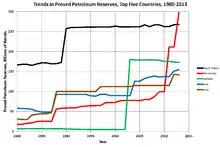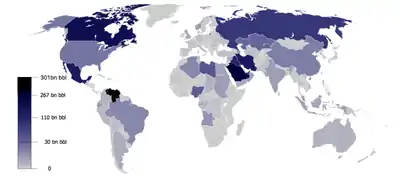List of countries by proven oil reserves
This is a list of countries by proven oil reserves. Proven reserves are those quantities of petroleum which, by analysis of geological and engineering data, can be estimated, with a high degree of confidence, to be commercially recoverable from a given date forward from known reservoirs and under current economic conditions.
---2017---US-EIA---Jo-Di-graphics.jpg.webp)


Some statistics on this page are disputed and controversial. Different sources (OPEC, CIA World Factbook, oil companies) give different figures. Some of the differences reflect different types of oil included. Different estimates may or may not include oil shale, mined oil sands or natural gas liquids.
Because proven reserves include oil recoverable under current economic conditions, nations may see large increases in proven reserves when known, but previously uneconomic deposits become economic to develop. In this way, Canada's proven reserves increased suddenly in 2003 when the oil sands of Alberta were seen to be economically viable. Similarly, Venezuela's proven reserves jumped in the late 2000s when the heavy oil of the Orinoco Belt was judged economic.
Countries
Reserves amounts are listed in millions of barrels. The column "Years until exhaustion" uses the daily production figures as of 2016[1] (multiplied with 365).
| Proven reserves (millions of barrels) | U.S. EIA (start of 2020)[2] | OPEC (end of 2017)[3] | BP (end of 2015)[4] | Other | Reserves-to-production ratio | |||||
|---|---|---|---|---|---|---|---|---|---|---|
| Country | Rank | Reserves | Rank | Reserves | Rank | Reserves | Source/Date | Reserves | Production (million bbl/year, 2016)[1] | Years |
| 1 | 302,809 | 1 | 302,809 | 1 | 300,900 | 831.1 | 362 | |||
| 2 | 267,026 | 2 | 266,260 | 2 | 266,000 | 3818.1 | 78 | |||
| 3 | 167,896 | 22 | 4,421 | 3 | 172,200 | Natural Resources Canada, end 2014[5] | 171,000 | 1336.8 | 126 | |
| 4 | 155,600 | 3 | 208,600[6] | 4 | 155,600 | 1452.9 | 109 | |||
| 5 | 145,019 | 4 | 147,223 | 5 | 143,100 | 1624.8 | 88 | |||
| 6 | 104,000 | 6 | 104,000 | 6 | 104,000 | 1067.2 | 95 | |||
| 7 | 98,630 | 7 | 98,630 | 8 | 98,630 | 1133.7 | 86 | |||
| 8 | 80,000 | 7 | 80,000 | 6 | 102,400 | 3851.3 | 21 | |||
| 9 | 48,363 | 8 | 74,363 | 9 | 78,400 | 366.1 | 131 | |||
| 10 | 47,053 | 10 | 32,773 | 10 | 55,000 | ENI, end of 2015[7] | 43,629 | 3239.7 | 10 | |
| 11 | 36,972 | 9 | 37,453 | 11 | 37,100 | 730.0 | 51 | |||
| 12 | 30,000 | 11 | 30,000 | 12 | 30,000 | 582.2 | 52 | |||
| 13 | 25,620 | 12 | 25,627 | 14 | 18,500 | 1452.9 | 17 | |||
| 14 | 25,244 | 13 | 25,244 | 13 | 25,244 | 555.9 | 45 | |||
| 15 | 12,999 | 14 | 12,634 | 15 | 13,000 | ENI, end of 2015[7] | 16,848 | 918.1 | 14 | |
| 16 | 12,200 | 15 | 12,200 | 17 | 12,200 | 492.1 | 15 | |||
| 17 / 18 | 8,273 | 16 | 8,384 | 16 | 12,700 | 645.9 | 22 | |||
| 17 / 18 | 8,273 | 17 | 8,273 | 19 / 20 | 8,000 | 200.2 | ||||
| 20 | 7,300 | 19 | 6,537 | 18 | 10,800 | PEMEX[8] Start of 2015 | 9.700 | 798.2 | 9 | |
| 21 | 7,000 | 18 | 7,000 | 21 | 7,000 | 304.2 | 23 | |||
| 22 | 6,611 | 20 | 6,376 | 19 / 20 | 8,000 | 601.5 | 11 | |||
| 23 | 5,373 | 21 | 5,373 | 23 | 5,300 | 367.5 | 15 | |||
| 24 | 4,600 | 23 | 4,495 | 22 | 5,680 | ENI, end of 2017[7] | 4,409 | 267 | 17 | |
| 25 / 26 | 4,400 | 24 / 25 | 4,400 | 29 | 3,500 | 180.4 | 25 | |||
| 25 / 26 | 4,400 | 24 / 25 | 4,400 | 25 | 4,000 | 110.2 | 40 | |||
| 27 / 28 | 3,600 | 29 | 3,310 | 27 / 28 | 3,600 | ENI, end of 2015[7] | 3,497 | 304.2 | 11 | |
| 27 / 28 | 3,600 | 28 | 3,600 | 27 / 28 | 3,600 | ENI, end of 2015[7] | 5,542 | 241.3 | 15 | |
| 29 | 3,000 | 30 | 3,000 | |||||||
| 30 | 2,564 | 32 | 2,069 | 31 | 2,800 | UK Oil & Gas Authority, end 2015[9] | 2,618 | 343.1 | 7.5 | |
| 31 / 32 | 2,500 | 30 | 2,500 | 32 | 2,500 | |||||
| 31 / 32 | 2,500 | |||||||||
| 33 | 2,185 | 31 | 2,162 | 33 | 2,400 | Argentine Petroleum Institute[10] | 2,330 | |||
| 34 | 2,002 | 34 | 1,665 | 34 | 2,300 | |||||
| 35 | 2,000 | 33 | 2,000 | 35 | 2,000 | |||||
| 36 | 1,821 | 26 | 3,985 | 26 | 4,000 | Geoscience Australia[11] end of 2014 | 4,002 | |||
| 37 | 1,600 | 36 | 1,600 | |||||||
| 38 | 1,500 | 37 | 1,500 | |||||||
| 39 / 40 | 1,100 | 35 | 1,100 | 39 / 40 | 1,100 | |||||
| 39 / 40 | 1,100 | 39 / 40 | 1,100 | |||||||
| 41 | 750 | 750 | ||||||||
| 41 | 660 | |||||||||
| 42 / 43 | 600 | 42 / 46 | 600 | |||||||
| 42 / 43 | 600 | 36 | 600 | 42 / 46 | 600 | |||||
| 44 | 594 | 37 | 594 | 42 / 46 | 600 | |||||
| 45 | 557 | 42 / 46 | 600 | ENI, end of 2015[7] | 595 | |||||
| 46 | 491 | 38 | 439 | 42 / 46 | 600 | ENI, end of 2015[7] | 550 | |||
| 47 | 473 | 38 | 1,400 | ENI, end of 2015[7] | 1,489 | |||||
| 48 | 425 | 47 / 48 | 400 | |||||||
| 49 | 396 | 47 / 48 | 400 | |||||||
| 50 | 395 | 39 | 395 | |||||||
| 51 | 350 | ENI, end of 2015[7] | 236 | |||||||
| 52 | 300 | ENI, end of 2015[7] | 284 | |||||||
| 53 | 243 | 41 | 700 | ENI, end of 2015[7] | 830 | |||||
| 54 | 211 | ENI, end of 2015[7] | 210 | |||||||
| 55 | 200 | |||||||||
| 56 | 198 | 40 | 198 | |||||||
| 57 | 180 | |||||||||
| 58 | 168 | |||||||||
| 59 | 159 | ENI, end of 2015[7] | 158 | |||||||
| 60 / 62 | 150 | |||||||||
| 60 / 62 | 150 | |||||||||
| 60 / 62 | 150 | |||||||||
| 63 | 145 | ENI, end of 2015[7] | 229 | |||||||
| 64 | 139 | |||||||||
| 65 | 139 | |||||||||
| 66 | 138 | ENI, end of 2015[7] | 151 | |||||||
| 67 | 125 | |||||||||
| 68 | 124 | ENI, end of 2015[7] | 124 | |||||||
| 69 | 113 | ENI, end of 2015[7] | 141 | |||||||
| 70 | 100 | |||||||||
| 70 | 83.9 | |||||||||
| 71 | 83.1 | |||||||||
| 72 | 72.4 | |||||||||
| 73 | 77.5 | |||||||||
| 74 | 71.0 | |||||||||
| 75 | 56.9 | |||||||||
| 76 | 44.1 | |||||||||
| 77 | 43.0 | |||||||||
| 78 | 40.0 | |||||||||
| 79 | 35.0 | |||||||||
| 80 | 28.0 | |||||||||
| 81 | 25.1 | ENI, end of 2015[7] | 35 | |||||||
| 82 | 20.0 | |||||||||
| 83 / 85 | 15.0 | |||||||||
| 83 / 85 | 15.0 | |||||||||
| 83 / 85 | 15.0 | |||||||||
| 86 | 12.7 | ENI, end of 2015[7] | 12 | |||||||
| 87 / 88 | 12.0 | |||||||||
| 87 / 88 | 12.0 | |||||||||
| 89 | 10.0 | |||||||||
| 90 | 9.00 | |||||||||
| 91 | 8.00 | |||||||||
| 92 | 6.70 | |||||||||
| 93 | 2.38 | |||||||||
| 94 | 2.08 | |||||||||
| 95 | 1.00 | ENI, end of 2015[7] | 1 | |||||||
| 96 | 0.68 | |||||||||
| 97 | 0.43 | |||||||||
| 0 | US Geological Survey[12] | 80 | ||||||||
| World total | 1,779,685 | 1,535,773 | 1,750,600 | 29427 | 59 | |||||
Different sources
Sources sometimes differ on the volume of proven oil reserves. The differences sometimes result from different classes of oil included, and sometimes result from different definitions of proven.
Comparison of proven oil reserves from some widely used sources (billions of barrels, as of 31 Dec. 2014/1 Jan. 2015)
| Source | Canada | Iran | Russia | Saudi Arabia | United States | Venezuela |
|---|---|---|---|---|---|---|
| BP[13] | 172.9 | 157.8 | 103.2 | 267.0 | 48.5 | 298.3 |
| OPEC[14] | 4.2 | 157.5 | 80.0 | 266.6 | 36.5 | 300.0 |
| US Central Intelligence Agency[15] | 171.0 | 157.8 | 103.2 | 268.3 | 36.5 | 298.4 |
| US Energy Information Administration[16] | 172.5 | 157.8 | 80.0 | 268.3 | 39.9 | 298.4 |
See also
References
- "Production of Crude Oil including Lease Condensate 2016" (CVS download). U.S. Energy Information Administration. Retrieved 27 May 2017.
- U.S. Energy Information Administration, International Energy Statistics, crude oil including lease condensate, accessed 17 June 2020.
- OPEC, Annual Statistical Bulletin 2018
- BP, BP Statistical Review of World Energy 2016, June 2016.
- Oil Resources, Natural Resources Canada, 16 Feb. 2016.
- OPEC Annual Statistical Bulletin for 2020
- ENI, World Oil and Gas Review, 2016.
- 20150909%20Reservas%20al%201%20de%20enero%202015_e.pd..., PEMEX, accessed 1 Sept 2016
- Oil and Gas reserves and Resources, UK Oil & Gas Authority, 5 Aug. 2016.
- Instituto Argentino del Petróleo y el Gas – Reservas comprobadas de petróleo, en miles de m3 (proven reserves as of 2013)
- Geoscience Australia, Oil, accessed 3 Sept. 2016. (crude oil + condensate).
- "Minerals in Afghanistan" (PDF). USGS Minerals gov. Retrieved 24 December 2013.
- BP Statistical Review of World Energy, 2015
- OPEC Statistical Bulletin, 2015.
- World Factbook, US Central Intelligence Agency, 2015.
- US Reserves: Curde Oil and Lease Condensate, US EIA.